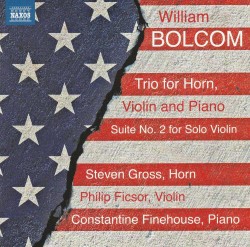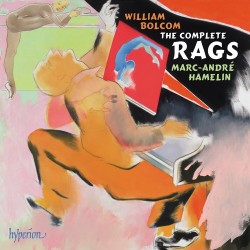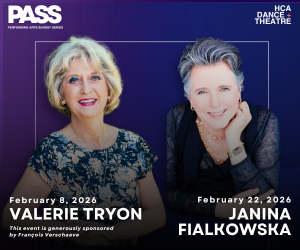 William Bolcom – Trio for Horn; Solo Violin Suite No.2
William Bolcom – Trio for Horn; Solo Violin Suite No.2
Steven Gross; Philip Ficsor; Constantine Finehouse
Naxos 8.579102 (naxos.com/catalogue/item.asp?item_code=8.579102)
William Bolcom – The Complete Rags
Marc-André Hamelin
Hyperion CDA68391/2 (hyperion-records.co.uk/dc.asp?dc=D_CDA68391%2F2)
William Bolcom (b.1938) is a renowned American composer whose works are wide-ranging, genre-bending and utterly fascinating. While Bolcom’s compositions from around 1960 employed a modified serial technique, under the influence of Pierre Boulez, Karlheinz Stockhausen and Luciano Berio whose music he particularly admired, in the 1960s he gradually began to embrace an eclectic use of a wider variety of musical styles. In addition to four large-scale operas and numerous concertos, Bolcom has also written nine symphonies, twelve string quartets, four violin sonatas, numerous piano rags, four volumes of gospel preludes for organ, four volumes of cabaret songs, three musical theatre works and a one-act chamber opera.
Chamber Works features two pieces, the Trio for Horn, Violin and Piano (2017) and the Suite No. 2 for Solo Violin (2011). The Trio showcases each instrument to its fullest in both soloistic and ensemble capacities and, while mostly atonal, the work incorporates brief moments of tonality that reorient the listener’s ears and provide a grounding element, especially in the more tumultuous movements. The Suite, conversely, is exquisitely tuneful and is clearly structured around the dance forms of Baroque solo violin suites, especially those of J.S. Bach. Rhythmic vitality and instrumental virtuosity reign supreme here, and the performance given by violinist Philip Ficsor is both admirable and noteworthy.
 The piano rag, (i.e. ragtime), is a musical style that reached its peak popularity between 1895 and 1919. A precursor to the development of jazz, ragtime is characterized by its syncopated or “ragged” rhythm and was popularized during the early 20th century by composer Scott Joplin and his school of classical ragtime. Although it fell out of favour in the 1920s, composers and performers alike have revived the styles and forms of the genre in the decades since, including Bolcom. His collection of rags is among the finest adaptations of ragtime within contemporary music, achieving a blend of stylistic familiarity and artistic creativity that is unique while avoiding appearing derivative or gauche.
The piano rag, (i.e. ragtime), is a musical style that reached its peak popularity between 1895 and 1919. A precursor to the development of jazz, ragtime is characterized by its syncopated or “ragged” rhythm and was popularized during the early 20th century by composer Scott Joplin and his school of classical ragtime. Although it fell out of favour in the 1920s, composers and performers alike have revived the styles and forms of the genre in the decades since, including Bolcom. His collection of rags is among the finest adaptations of ragtime within contemporary music, achieving a blend of stylistic familiarity and artistic creativity that is unique while avoiding appearing derivative or gauche.
And who better to handle Bolcom’s ingenious rags than Marc-André Hamelin, perhaps Canada’s premier interpreter of contemporary music? As someone who successfully handled the seemingly insurmountable piano works of Kaikhosru Sorabji and Charles-Valentin Alkan, Hamelin’s name is synonymous with “unplayable” scores that transcend the conventional understanding of virtuosity. Here, however, he lends his deft touch to material that is considerably less demanding from a technical perspective yet has certain stylistic requirements, the challenges of which he meets with precision and sensitivity.
For those familiar with the music of Bolcom, both of these recordings are guaranteed to be a delight; they also serve as fine starting points for those who are unfamiliar. The Complete Rags adapts an old yet familiar style through a master performer’s touch, while Chamber Works provides a glimpse into Bolcom’s more modern approach, a perfect pairing for anyone interested in this icon of American modernism.



